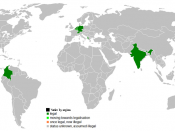Death is a fact of life. And sometimes death can be painful. A small percent of people say that when death is painful, the person should be relieved of the agony of life. Euthanasia is what the term is for "having mercy" and ending a person's life. A large number of people in the United States do not condone euthanasia. I do not believe in euthanasia. Pain and suffering of a patient is not an excuse to end the life of another human being. I believe that anyone who carries out the act of euthanasia of any human is a murderer.
Before I talk about the history of euthanasia, I first need to define what euthanasia is. Euthanasia is of Greek origin, meaning "a good health." In the dictionary it is defined as "the act of killing a person painlessly for reasons of mercy." The Euthanasia Society of America defined it as "the termination of life by painless means for the purpose of ending severe physical suffering."
This act of killing can be carried out in several ways.
The ways that euthanasia is carried out are the following: passive, voluntary active, involuntary active, assisted suicide and physician assisted suicide. Passive euthanasia is the act of stopping all medical care. Such medical care that can be withheld is a respirator, life sustaining medicines, and food. Voluntary euthanasia is acted upon by the patient's request. Involuntary active euthanasia is the killing of the patient without permission, for example, incompetent adults and babies. Assisted suicide is usually under the guidance of a doctor, a member of the family or close friend. This person provides the knowledge and means to commit the suicide. Physician assisted suicide is the act of a doctor directly causing the death of a terminally ill patient. Doctors commonly...



Stolen Section
A part of the essay was stolen from:
http://www.btcoc.com/98sloan.htm
7 out of 7 people found this comment useful.